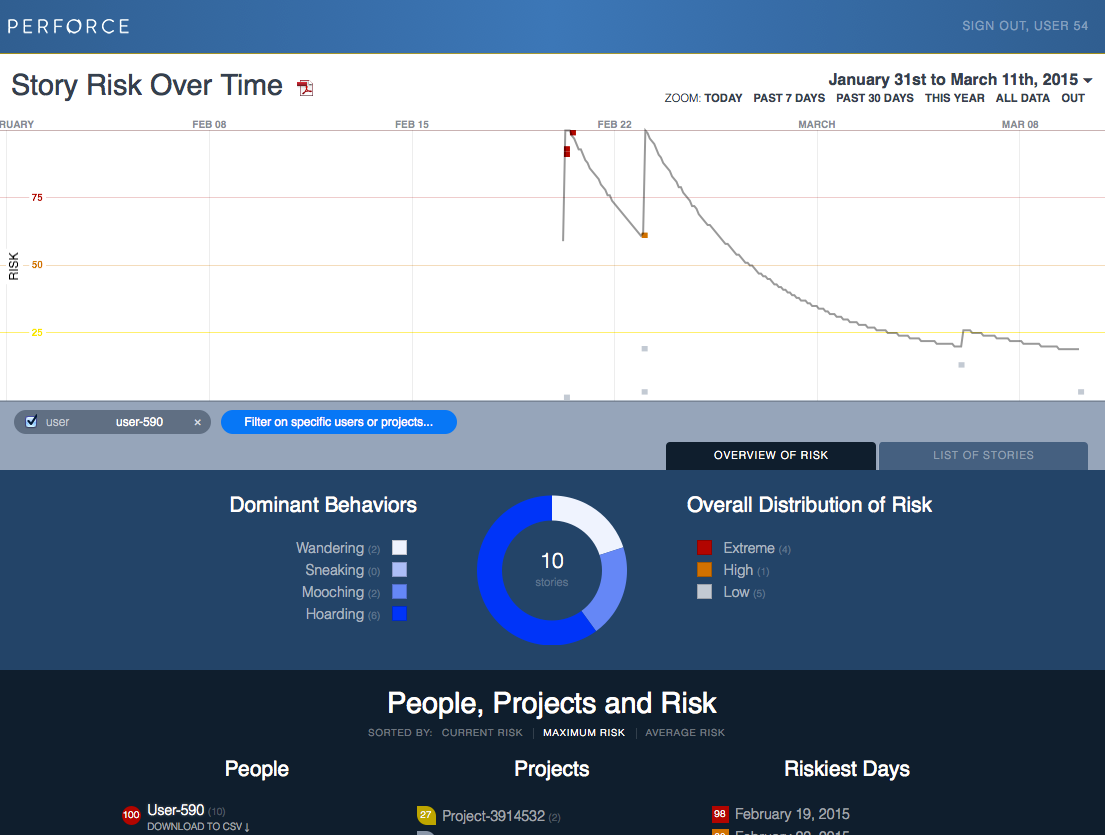Clients, Collaboration, and Security
In addition to its core offering of products—the Helix Versioning Engine and the Helix client applications—Perforce offers a number of tools and software packages that allow you to analyze your data, enhance collaboration on your coding projects, and seamlessly integrate Helix into interactive development environments.
Client applications
Helix client applications include the following:
- A command line interface available for all platforms.
- A GUI interface for Mac OS X, UNIX, Linux, and Windows.
- Integrations, or plug-ins, that work with commercial IDEs and productivity software.
Analytics tools
Perforce offers two tools for analysis: Helix Insights and Helix Threat Detection.
Helix Insights
Helix Insights is an analytics tool that presents vital information about how your projects, codelines, and teams are performing. Insights draws on data from the Helix Versioning Engine and logs, displaying it in graphical form so that you can quickly understand what’s going on.
Insights reports on project stability by examining bug and submit activity. It also lets you visualize metrics for change, contributions, and issue tracking.
The following figure shows some of the information and analysis provided by Insights.

Using Insights, you can customize analytics dashboards to get a view into your system and analyze any information from Helix or third-party sources. You can also employ the Insights Analytics API to set custom metrics.
Finally, you can export Insights data for use in third-party analytics tools (for example, Splunk or Tableau).
Helix Threat Detection
Helix Threat Detection quickly and accurately identifies internal and external security risks to intellectual property managed in Helix. Applying advanced behavioral analytics to interactions with source code, product designs and related assets stored in Helix, Helix threat detection proactively surfaces threats in real time and assesses the risk level for each threat event.
Helix Threat Detection effectively distinguishes actual threats from “noise.” It features an intuitive graphical interface and plain-language reporting, linked to analytics and machine learning, that enables you to successfully protect valuable intellectual property assets.
The following figure illustrates how Helix Threat Detection displays possible thefts over time.

Collaboration
Using the Helix Swarm and Helix GitSwarm collaboration tools, your team can work together effectively on complex and extensive sets of data and code.
Helix Swarm
Helix Swarm is a web-based collaborative tool for small to medium teams sharing code and assets. It provides functionality to review, comment upon, and approve changes to code and assets. Using Swarm, you can customize projects, memberships, and reviewers.
Helix Swarm helps you review code before or after committing it, bring continuous integration into the review, and merge work that passed the review. It integrates cleanly with JIRA and Helix Jobs, and provides an API for the development of custom extensions.
Helix GitSwarm
Helix GitSwarm is Perforce’s code review solution for Git users. Built on the open source product GitLab, it includes Helix-specific enhancements to support both Git and Helix code reviews. It allows users to push their code, review others' code, comment, and track issues.
Helix GitSwarm offers a pure Git-based workflow and an intuitive web-based UI. In addition to keeping your Git-based projects in Helix, GitSwarm allows you to mirror content from repositories in other popular tools such as GitHub and GitLab. It also allows you to restrict who can see what projects, as well as providing other security mechanisms. In addition, it provides issue tracking and project Wikis.
Integration
Helix includes two types of integration plugins: plugins for integration into interactive development environments and plugins for build and reporting integrations.
Interactive development environment integrations
- The P4VS plugin embeds the power of Perforce Helix features into the Microsoft Visual Studio IDE.
- The P4Eclipse plugin integrates the strengths of Perforce Helix with Eclipse’s powerful IDE.
- P4Connect, the Perforce Helix Plugin for Unity, enables you to perform Perforce Helix operations directly from within Unity.
You also have access to many community-built integration plugins, which are summarized on the Perforce website, on the Helix Clients & Integrations page.
Build and reporting integrations
Helix offers three main build and reporting integrations: one for the Jenkins build system, one to query from Helix into a SQL database, and one providing an FTP interface to the Helix Versioning Engine:
- The Jenkins integration allows Jenkins users to use Helix repositories directly. The plugin makes it simple to pull code, automate reviews, apply labels, and so on.
- The P42DB integration replicates Helix metadata to open source and commercial SQL databases.
- The P4FTP integration allows FTP-based HTML authoring tools such as Dreamweaver to access files in Perforce Helix depots.